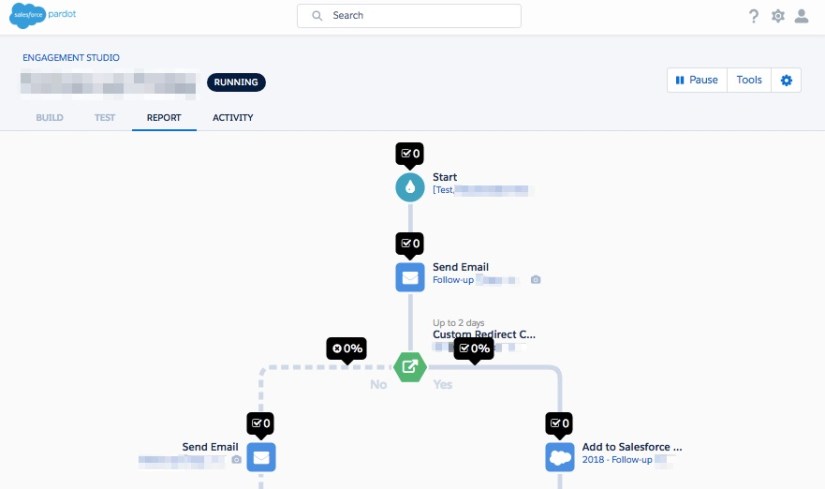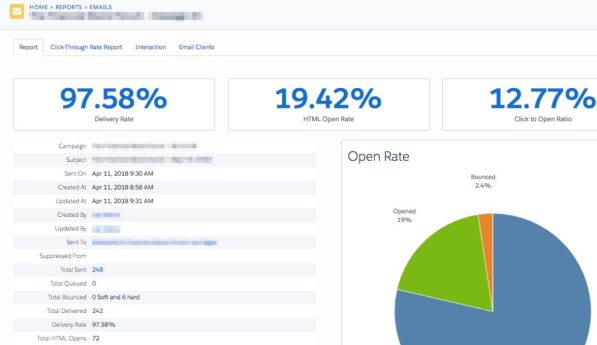Email has persisted as the cornerstone of Marketing Automation, more stable than other digital marketing channels that experience sharp peaks and troughs in popularity. Email Marketing is essential particularly in B2B Marketing, where audiences tend to live in their inboxes.
The high Return on Investment (ROI) up for grabs for Email Marketing is what makes it stand the test of time. Not only can ROI be high, but it can easily be tracked and reported on, especially when using best-of-breed Marketing Automation, such as Salesforce Pardot. With metrics pumping in, fairly soon all eyes will be on the Email Marketing strategy.
You may have your email templates, or your audience, or your objectives – but can you hand on heart call this ensemble a strategy? This post will cover how to start turning single emails and disparate interactions into a tighter strategy, addressing:
- Goals & Benchmarks
- Audience
- The Email
- Sending
- Deliverability
- Reporting – Engagement
- Optimisation
Goals & Benchmarks
As predictable as daylight, point No. 1 is about defining Goals and awareness of Benchmarks. Before you click off this post, wait! I’m going to condense it down, with no fluff.
- Goals: Marketing teams have KPIs; if these are high-level, work back until you reach goals at the individual email level (eg. number of clicks required in order to reach conversion goals).
Benchmarks: there are two places to look for benchmarks. Firstly, your own historical email data. Secondly, dig around some industry research; two great references I use are SmartInsights’ compilation, and Mailchimp’s tables, updated regularly.
Audience
Yes, email continues to thrive, but mass mailing has been long-dead; in fact, blast emails can quickly do irreversible damage to your reputation as a sender. So, segment smarter and avoid marketing fatigue!
Account-based Marketing (ABM) has been a trend on people’s radar for the past year. ABM involves persona-focused segmentation – good news for email marketing strategy. You can get started today in Pardot by checking and enriching the data in two particular fields:
- Job Title
- Department
Use Pardot Segmentation Rules, or Dynamic Lists to take care of audience segmentation. Using these two persona-focused fields as the basis of segmentation sets you up for success. Why? You can send ‘stickier’ email copy that addresses the desires and fears (pains points) of the human that sits behind the email address.
Another aspect to consider with audience, is marketing fatigue – the tough situation when your emails begin to lose their impact with your Prospects. To solve this, use Recency & Frequency lists as part of your plan. Being tactical trumps tormenting Prospects, even if it does mean letting go of a fraction temporarily. Marketing fatigue can have serious consequences; continually marketing to unengaged Prospects will damage your deliverability – trust me, I’ve witnessed it.
The Email
The email itself is your portal to your target buyer, so consider the content and design carefully.
- Content: humans are self-interested, and email copy should appeal to their worldview. If attention is a currency, a person will only pay you so much before it’s spent.
- Design: the design should aid the recipient in understanding what action you want them to take, also known as ‘call to action’ (CTA). Too many emails are overloaded with design, therefore distracting or overloading the reader. Consider restricting clickable places in the email body, making CTA buttons clear, and keeping common ‘blocks’ consistent (eg. social sharing buttons, email preference centre).
Building out Email Templates in Pardot and having a clear naming convention mitigates users using rogue templates (which, let’s be honest, are obvious to spot). Remember, the email is your portal to your target buyer, so quality and consistency go a long way.
Sending
Before you click send, think is this email one-off, or should it be part of a larger nurturing flow? Surely, if you have defined a call to action in your email (point 3), then it shouldn’t be sent and forgotten about.
Rethink marketing automation as a series of reusable and defined flows to avoid isolating emails. Use Pardot’s Engagement Studio to connect the dots between your emails and your call to actions. Engagement Studio takes the leg-work out, being able to listen if a specific call to action has been made, and trigger any action from that.
Even if you do insist that this is a one-off email (think Christmas greetings), then sending as a solo ‘List Email’ is fine. Supplement List Emails with automation (ie. Completion Actions) to give list emails a greater purpose and build richer pictures of customer behaviour.
Above: an example Engagement Studio program.
Deliverability
You press ‘Send Now’ and wait for the number to roll-in. For countless organisations, this complacency will result in Email Marketing failure, even if the strategy looks solid on paper.
Deliverability means asking: did your email even get into recipient inboxes? Unfortunately, poor deliverability plagues marketers, known as the ‘SPAM-trap’. Emails get caught by SPAM filters that email clients (eg. Gmail, Yahoo!) use to protect their customers. SPAM filters will pick up on the following:
- Image to text ratio*: SPAM filters are aware that spammers use text within images as a way to bypass filters.
- ‘Spammy’ words in subject lines, eg. free offer, guaranteed, Act Now!
- Continually sending emails, even if the recipient is not responsive (ie. no opens etc.)
Therefore, some actions to take are:
- Use that built-in SPAM analysis tool (image below)
- Segment audience based on engagement. After some time of unresponsiveness, it may be time to wave goodbye to this data.
- Ensure your Bounce rate remains low’ in Pardot, the threshold is <10%, but aim for <4%.
*although this is known industry best-practice, some experimenters debate this – so take it with a ‘pinch of salt’.
Reporting – Engagement
Once your email has sent, it will appear in the Sent Email report table. To find this, navigate to: Reporting → Marketing Assets → Emails.
From here, you can drill down to the report for each individual email, which will look similar to the below image:
You can interpret these results to bring life to these 2-dimensional numbers, for instance:
- Low open rate = poor subject line
- High open rate but low click rate = poor email copy, or position/visibility of call to action buttons.
- High click-through rate, but no conversions = poor prospect journey, offering too weak.
What picture does this draw when these insights are all put together? Bring it back to your benchmarks (point 1).
Optimisation
We all want to get better. Optimisation is absolutely key in striving for the most impactful email marketing strategy. After analysing the results from a few emails, it’s time to kick start optimisation tactics, such as:
- A/B Testing; to test subject lines, call to action text/positioning, email body. Adjust the sample size and to your liking.
- Engagement Studio; allowing you to create new ‘versions’ of a program by switching out email templates in email steps.
- Schedule sends for different times of the day
Summary
This post has covered how to implement an email marketing strategy with Pardot. The purpose of an email marketing strategy is to turn single emails and disparate interactions into a tighter strategy, addressing 7 parts pre- and post-sending. As email has persisted as the cornerstone of Marketing Automation, and often the first thing people attempt in Pardot, getting a strategy in place early on is a wise move, and not to be underestimated!




